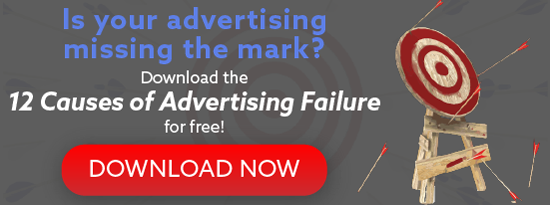Missouri Marketing Resource Blog

12 of 12 Causes of Advertising Failure: Response vs. Results
 Welcome back to the 12th and final part in the causes of advertising failure series. Over the past 12 weeks we’ve brought you some of the most common marketing missteps that many business owners fall victim to. From the desire for instant gratification to great production, poor copy, and nine more failures in between. We’ve given you tools of the trade, industry examples, and insightful know-how to overcome some prevalent advertising flops in order to generate a captivating and successful marketing campaign.
Welcome back to the 12th and final part in the causes of advertising failure series. Over the past 12 weeks we’ve brought you some of the most common marketing missteps that many business owners fall victim to. From the desire for instant gratification to great production, poor copy, and nine more failures in between. We’ve given you tools of the trade, industry examples, and insightful know-how to overcome some prevalent advertising flops in order to generate a captivating and successful marketing campaign.
We all agree that the goal of advertising is to get results. But often it can be confused with the desire to get responses. While you may get a lot of feedback from your advertising, if it isn’t converting prospects into customers, it’s simply not effective. With thousands of advertisers vying to get consumer attention, it is important to have a well thought-out campaign that avoids as many pitfalls as possible. As such, in this article, we’ll highlight advertising failure #12: response vs. results.
To get results from your advertising you first need to craft a clear message for your marketing, making sure that it’s prominent and easy to digest for your prospects. It’s important to know your brand and share its unique story with consumers. Unfortunately, most marketers evaluate the success of their ads by comments or visceral responses they hear from the people around them. The most visually pleasing, funniest, and clever ads may produce great feedback, but are they actually generating traffic, leads, sales, or even results?
A Story in History
Let’s take a look back at a successful advertising campaign where everything was risked, and so much was gained. It’s a reminder about how important advertising is, and how innovation will truly drive results, helping your brand break free from the clutter of all the messages consumers are exposed to on a daily basis.
In 1891, William Wrigley Jr. came to Chicago with $32 in his pocket and a dream of starting a chewing gum business. In 1907, he did the unthinkable. When all other business were pulling funds from marketing efforts due to a debilitating economic depression, Wrigley made it a priority to remain top-of-mind with consumers and launch an advertising campaign. Even though he was only able to do this by mortgaging everything he owned to raise the money, the bold move skyrocketed Wrigley's into the national arena and set the stage for the company’s future groundbreaking advertising strategies.
A few decades later, he organized the first-ever nationwide direct marketing campaign — shipping sticks of gum to every address listed in the U.S. phone book. He is remembered as coining the statement “Tell ‘em quick and tell ‘em often.” A saying that we still reference today with the idea that frequency is king.
There is a reason we all know the Wrigley name a century later. By creating powerful advertising campaigns the company has been able to reap the rewards. The Wrigley advertising campaigns are not just attention-grabbing. The foundation of their ads follows through with the true goal of advertising — to get results. By having a quality product, retaining loyal customers through decades, and telling a compelling story through advertising, Wrigley lives on as a true advertising pioneer.
Characteristics of Ads That Get Results
They’re Simple
Ads that get results generally have similar characteristics. For one, they’re easy to understand. What’s the point of spending money on an advertising campaign if it doesn’t land with your audience? Sure, you can pull out all the bells and whistles with fancy production and sound effects, but if your message is not clear to the consumer, what have you accomplished?
It’s also important to keep your copy simple; don’t use industry jargon or talk over the heads of your audience. If your message does not resonate with your target audience, you’ve wasted marketing dollars.
You must also make sure your creative is appropriate and in line with your business and your audience’s needs. For example, does your ad take a humorous tone when it should be more serious? While these things might seem small, presenting your ad in the wrong light could be a huge turn off for some.
Address Needs and Solve Problems
Another common characteristic of great ads is that they make sure to address a need or solve a problem for the audience. Your ad needs to answer this question: what’s in it for me? Consumers are bombarded with ads on a daily basis. They have so many choices as far as where to spend their money, and if you’re looking for them to invest in your brand, tell them why they should! How will your product or service impact their lives in a positive way? How will your solutions make their lives happier, better, easier?
To do this, you really need to tap into the psyche of your audience. Knowing who you’re targeting allows you to understand their problems. With that, speak to how you can fix them. Prevention doesn’t sell. What does sell is a product or service that satisfies a need and solves problems quickly, better than any other product or service on the market.
Captivating Calls-to-Action
On top of that, getting results requires you to focus on one goal at a time. For example — Get a Quote, Call For an Appointment, Contact Us Today — are all great ways to convert leads and drive sales, but you’ll need to pick one of them to focus on. Many advertisers try to throw everything at the wall just to see what will stick. By doing this, you’ll end up with confused and disengaged consumers. Instead of being vague and hoping something you say will resonate, create a strong message that clearly tells your audience what you want them to do or what they’re going to receive by taking action.
Which brings us to our next point — have a clear call-to-action (CTA). Your call-to-action is a short phrase that compels your listener to take action; it’s what can convert your prospects into leads. Your CTA must be powerful and persuasive, but most importantly, remember to keep it simple. And be specific as to how you want people to get a hold of you. Pick one form of contact instead of telling them your address, phone number, website, and social handles in every ad.
Final Words
The truth of the matter is, people don’t just rush into your business shouting “I’m here because I heard you on the radio!!!” And it’s important to remember that. Consumers travel through many steps on their buyer’s journey before they’re ready to make a purchase. Results are when your cash register rings, and sales go up — who cares if anyone tells you they heard your ad if your bottom line is growing?
Throughout this series, we’ve compiled a dozen advertising failures, addressed each one, and provided information regarding how you can avoid falling victim to each them. We covered topics like having a big reach but a small budget, the mindset that “business owner knows best” and why improper use of passive media can be a huge blunder to your bottom line.
If you haven’t already, take some time to read the previous posts in this series. And if you have followed us on this insightful and educational 12-week journey, thank you! We hope you had as much fun reading them as we did writing them!
The 12 Causes of Advertising Failure courtesy of Roy H. Williams , author of The Wizard of Ads & Secret Formulas of the Wizard of Ads.

